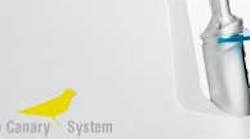Quantum Dental Technologies has released a software upgrade for The Canary System, bolstering the caries detection system with new features to help dental professionals make efficient and informed decisions in their patients’ caries management.
The “Quick Scan” option is a new feature in The Canary System software. Dental professionals can now perform Canary Scans repeatedly without first selecting the patient name, tooth number, tooth surface, and tooth region. For a quick scan to see the Canary Numbers for particular tooth regions, this is the perfect scanning option. The previous five Canary Number readings are maintained at the side of the interface for quick reference.
The conventional Canary “Detail Scan” option is recommended for users who want to associate Canary Number data to a specific patient and tooth/surface and save the scan for future reference. One now has the option of selecting either the “Quick Scan” or “Detail Scan” for a Canary scan session, two different options for using this accurate caries detection tool.
Dr. Steve Goren, a Toronto dentist, is excited about this new feature. “The addition of the ‘Quick Scan’ feature gives us the flexibility to perform a detailed Canary scan, providing a comprehensive picture of the patients’ status of tooth decay, as well as a quick and easy way to determine whether a tooth region is decayed or not. All of this will help me develop a more patient-centred approach to delivering the best in caries management for our patients.”
The Canary System, powered by the energy conversion technology PTR-LUM, is a low-powered laser-based device integrated with an intraoral camera that uses a novel combination of heat and light to directly examine the crystal structure of teeth and map areas of tooth decay. The Canary System is a revolutionary new tool that can detect, map and monitor carious lesions on any tooth surface.
The Canary system detects tooth decay along the margins of restorations, including amalgam and composite resins, and beneath fissure sealants. It detects lesions earlier than X-rays up to 5 mm beneath the tooth surface. The Canary System’s interactive software and printed patient reports engage patients in their own oral healthcare. Visit www.thecanarysystem.com or email [email protected] to request additional information.
For related news, visit The Canary System: a solution for detecting caries around restoration margins.





